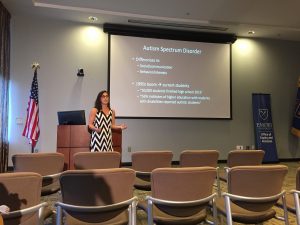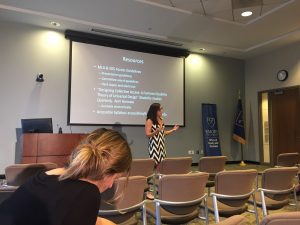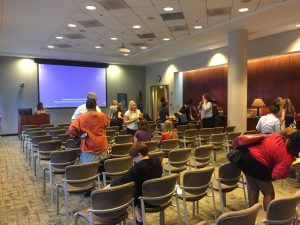When I drove up to Raoul Hall on move-in day, I was greeted by three eager-looking sophomores ready to help. After exchanging brief introductions, they proceeded to lug all of the boxes to my room, leaving my mother and me empty-handed. Although these students had just moved in a few days ago themselves, they were committed to making my move-in day experience seamless.
Emory’s culture of designating Resident Advisors (RAs) and Sophomore Advisors (SAs) to oversee freshmen’s college transition and well-being speaks to the strength of the greater school community. These students may end up in the same classes, clubs, and parties as their residents, but they commit themselves to helping new students face the same challenges they have.
While Residence Life staff are all motivated by different goals and appreciate different aspects of their roles, they come together to foster community for themselves and for incoming students.
Freshman, reach out to your RAs and SAs. Use them as resources. They have found their places at Emory, and they are here to help you find yours.
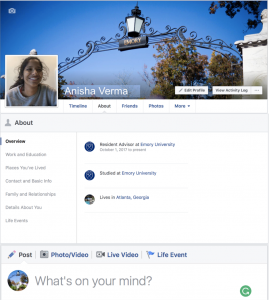
*What’s your name?*
Anisha: Anisha Verma.
*Where are you from?*
Anisha: Wisconsin
*What Emory class are you in?*
Anisha: I’m a senior.
*What Emory clubs do you belong to?*
Anisha: I am in ECAST which is the Emory Climate Analysis Solutions Team, and EUSAC which is the Emory University Sustainability Advisory Council. And I’m part of Campus Kitchens. Um, I’m really into running. I like reading, writing, working.
*What motivated you to be an SA/RA?*
Anisha: I really liked my RA my freshman year. She was just a lot like me, I guess, in terms of like of how she was super sarcastic and people thought she was being mean but she was just being herself and, like, making jokes, and I have that problem a lot too. So I just kind of like try to establish some ground form of, like, friendship before I start, you know, cracking jokes, being mean, that sort of thing, yeah. And, um, I thought that Res. Life would be a cool and welcoming community to be a part of throughout the next three years at Emory. And yeah I really like helping the First Years with their adjustment to Emory.
*What has been the most rewarding part so far?*
Anisha: I think when like I see my residents from sophomore and junior year, and they’re like still really excited to see me, and they — because I think there’s like no way to tell whether or not you’re doing a good job as an RA, and so like when there – they still wanna be your friend and wanna be around you it kinda makes me feel that I’m doing something right.
*What was the hardest part of your freshman year?*
Anisha: Um, all my friends joined Greek life, and I did not, so they were kind of like we don’t really need you anymore because we have all of these new, hip, and cool friends who are in my sorority and fraternity. And then, I was kind of left alone with no friends. (Laughs) But it’s fine.
*What would you tell your freshman self?*
Anisha: I would tell my freshman self to stop talking as much, because I still have this problem where I’ll have something to do but then somewhere I’ll see someone and I’ll be like you know this conversation will be worth more in the long run than me studying for this test and getting a good grade, which isn’t always true. Um, so, you know like prioritize more efficiently I guess.
*What do you think makes the Emory community so unique?*
Anisha: There’s an Emory community? I don’t know. I think people are just kind of like doing their own thing. You’ll know what I mean when you like spend more time here.
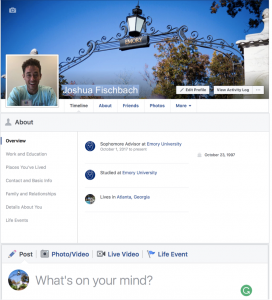
*What’s your name?*
Josh: Hi, my name is Joshua Fischbach.
*Where are you from?*
Josh: I’m from Ann Arbor, Michigan.
*What Emory class are you in?*
Josh: I am part of the Class of 2020.
*What Emory clubs do you belong to?*
Josh: I really like soccer, music, uh, different cultures, language. So I’m part of the club soccer team at Emory. I’m part of, um, Emory Students for Israel. I’m, uh, hopefully going to be part of TEDx at Emory. Um, and then I do, uh, and then I do, um, Coaching Corps. Um, I’m also part of Res. Life, so I’m a Sophomore Advisor.
*What motivated you to be an SA/RA?*
Josh: I thought it’d be a good way to get involved in the Emory community, uh, and it’d also be a great way for me to reach out and meet, uh, a diverse range of people from different backgrounds and be able to help them transition into college.
*What has been the most rewarding part so far?*
Josh: So far I’ve really liked, uh, the relationships that I’ve formed, um, both with my fellow SA — fellow Res. Life staff members and also with, um, the residents.
*What was the hardest part of your freshman year?*
Josh: The hardest part of my freshman year was probably, um, figuring out ways to manage my time, uh, efficiently so that I wouldn’t, um, be stressed out or constantly drag out work so definitely organization — time management in order to succeed here.
*What would you tell your freshman self?*
Josh: I would tell my freshman self to, you know, don’t worry about anything, like, social pressure, academic pressure, you know…it’s all trivial…just be happy and enjoy yourself, where you are in life.
*What do you think makes the Emory community so unique?*
Josh: There’s a diverse range of people in the community, so you can find really any type of person that would sort of — sort of fit into any type of category or label that you want, so there’s –there’s people for everyone here which is really nice. There’s not just one type of student or one type of person.
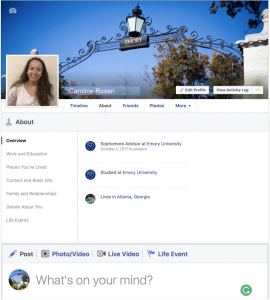
*What’s your name?*
Caroline: Caroline Rosen.
*Where are you from?*
Caroline: Pennsylvania.
*What Emory class are you in?*
Caroline: I’m the Class of 2020.
*What Emory clubs do you belong to?*
Caroline: I’m on the club gymnastics team. Obviously, I’m involved in Res. Life, and I’m on the executive board for Emory Miracle.
*What motivated you to be an SA/RA?*
Caroline: I was very close with my SAs and RAs last years, and I really liked their role of getting to know the residents and helping people adjust to college, and I wanted to do that too.
*What has been the most rewarding part so far?*
Caroline: Meeting my residents.
*What was the hardest part of your freshman year?*
Caroline: The hardest part of my freshman year…was probably getting sick. That sucks. And like the whole hall was sick, it was a nightmare.
*What would you tell your freshman self?*
Caroline: Um, calm down. Everything will be fine in terms of your social life, and academics, and everything
*What do you think makes the Emory community so unique?*
Caroline: I think we all are, you know, very involved in academics, but also really value spending time with spending time with the people we care about and being involved, uh, outside of academics.

*What’s your name?*
Kevin: My name is Kevin Niu.
*Where are you from?*
Kevin: I’m from Canton, Ohio.
*What Emory class are you in?*
Kevin: I’m part of the Emory Class of 2020.
*What Emory clubs do you belong to?*
Kevin: Some of my interests would include definitely music, I play piano, I’m an avid rock climber. Um, in terms of extra-curriculars I’m part of the club swim team here, I’m part of Student Programing Council, and as well as Emory Student Ambassadors.
*What motivated you to be an SA/RA?*
Kevin: Being an SA sounded like a really good opportunity to meet people while also having fun. The idea of second year housing just didn’t seem appealing to me, in the sense that nobody was going to try and establish a sense of community. Um, and I thought first-years would be more willing to have engaged conversations with people who they lived near — they live near.
*What has been the most rewarding part so far?*
Kevin: I think it’s been really neat to see everybody kind of find their way through Emory and see, like, who these people were when they got here and kind of the things they get involved with afterwards, and kind of see people discovering new things.
*What was the hardest part of your freshman year?*
Kevin: I think the hardest part of freshman year was there were a lot of times where you’d feel very alone just because you had a lot of friends, but you’ve only known them for, like, two or three months and so you don’t really trust them the way that you did people back home. And I think that was one of the most significant challenges, learning how to cope with issues and problems on your own.
*What would you tell your freshman self?*
Kevin: I would probably tell my freshman self that the biggest way to, like, succeed in college is to just push through, uh, because there’s a lot of stuff that happens in college, um, a lot of times where you feel like, you know, you’re just under way too much stress and under way too much pressure. Um, and I think being able to find things to look forward to is a great way to kind of keep yourself moving.
*What do you think makes the Emory community so unique?*
Kevin: I think the fact of the matter is that anybody who really tries to fit in to the Emory community will fit into the Emory community. I think at other places in it at like state schools or extremely small liberal arts college it is very possible that it’s not a good fit for someone, but I think at Emory, like, everybody is, like, welcome and everybody has the potential to find a community here.
https://www.youtube.com/watch?v=-SuVg-C5YZA

